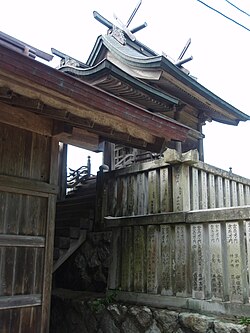Hare of Inaba


TheHare of Inaba(Nhân phiên の bạch thố,Inaba no Shirousagi)can refer to two distinctJapanese myths,both from the ancientprovince of Inaba,now the eastern part ofTottori Prefecture.The Hare of Inaba legend belongs to theIzumo denrai,or tradition of myths originating from theIzumo region.[1][2][3]The Hare of Inaba forms an essential part of the legend of theShintogodŌnamuchi-no-kami,which was the name forŌkuninushiwithin this legend.[4]
The hare referred to in the legend is theLepus brachyurus,orJapanese hare,possibly the subspecies found on theOki Islandsknown as theLepus brachyurus okiensis.The Japanese hare ranges between 43 centimetres (17 in) and 54 centimetres (21 in) in length, and is much smaller than the commonEuropean hare.Japanese hares are typically brown, but may turn white during winter in areas with a varying climate, such as that of the Inaba region.[5][6]
Kojiki version[edit]
One version of the tale of the Hare of Inaba is found in theKojiki,the oldest extant chronicle inJapan,which dates from early in the 8th century (711-712). The legend appears in the first of the three sections of theKojiki,theKamitsumaki,also known as theJindai no Maki,or "Volume of the Age of the Gods". This section of theKojikioutlines the myths concerning the foundation of Japan prior to the birth of theEmperor Jimmu,thefirstEmperor of Japan.[1]
In theKojikiversion of the myth, aharetricks somewanizame[a]into being used as a land bridge in order to travel from theIsland of OkitoCape Keta.Cape Keta is now identified with the Hakuto Coast in the present-day city ofTottori.[9][10]The hare challenges the sharks to see whose clan is larger—that of the sharks, or that of the hares.[3]The hare had the sharks lie in a row across the sea. The hare then hopped across them, counting them as he went. Nearing the end, the hare exclaims that he has deceived the sharks in order to use them as a bridge. The last shark attacks the hare, ripping his fur from him.[2][3]
Ōnamuchi-no-kami (Ōkuninushi's name at that time) and his eighty brothers were traveling through the Inaba region to wooPrincess Yakamiof Inaba.[11]While the brothers were on their way to visit the princess, the flayed hare stopped them and asked them for help. Rather than helping the hare, they advised it to wash in the sea and dry itself in the wind, which naturally caused it great pain.[11]In contrast, Ōnamuchi, unlike his quarreling elder brothers, told the hare to bathe in fresh water from the mouth of a river, and then roll in the pollen ofcattails.[2][3]The body of the hare was restored to its original state, and after its recovery, revealed its true form as a god.[12]In gratitude, the hare told Ōnamuchi, the lowest born in the family, that he would marry Princess Yakami.[13]
The Hare of Inaba legend emphasizes the benevolence of Ōnamuchi, who was later enshrined at theIzumo-taisha.[3][14]Japanese scholars have traditionally interpreted the struggle between the kind Ōnamuchi and his wrathful eighty brothers as a symbolic representation of civilization and barbarism in the emergent Japanese state.[13]
The version of the Hare of Inaba legend told in theKojikihas been compared to similar myths fromJavainIndonesia,Sri Lanka,andIndia.[3][11]
Ise ga Naru version[edit]
Long ago, when Japanese goddessAmaterasuand her entourage traveled around at the boundary of Yakami in Inaba, they were looking for a place for their temporary palace, suddenly a white hare appeared. The white hare bit Amaterasu's clothes and took her to an appropriate place for a temporary palace along Nakayama mountain and Reiseki mountain. About two hours' walk, accompanied by the white hare, Amaterasu reached a mountain top plain, which is now called Ise ga naru. Then, the white hare disappeared at Ise ga naru.[15]
The place of this legend is in Yazu town andTottoricity, inTottori Prefecture(ancient Inaba and Houki), where the shrineHakuto Jinjareveres the white hare.[12]
Footnotes[edit]
- ^Wanizamemay refer to thewani,adragonorsea monsterinJapanese mythology.In theSan'in region,from which the myth originates,wanizameis synonymous with the common shark.[7][8]
References[edit]
- ^ab"Nhân phiên の bạch thố"[Hare of Inaba].Nihon Kokugo Daijiten(in Japanese). Tokyo: Shogakukan. 2013.OCLC56431036.Archived fromthe originalon 2007-08-25.Retrieved2013-01-26.
- ^abc"Nhân phiên の bạch thố"[Hare of Inaba].Dijitaru Daijisen(in Japanese). Tokyo: Shogakukan. 2012.OCLC56431036.Archived fromthe originalon 2007-08-25.Retrieved2012-12-14.
- ^abcdef"Nhân phiên の bạch thố"[Hare of Inaba].Nihon Daihyakka Zensho (Nipponika)(in Japanese). Tokyo: Shogakukan. 2013.OCLC153301537.Archived fromthe originalon 2007-08-25.Retrieved2013-01-26.
- ^Doniger, Doniger, ed. (1999).Merriam-Webster's encyclopedia of world religions.Springfield, Mass.: Merriam-Webster. p.824.ISBN9780877790440.
- ^"ノウサギ"[Japanese hare].Nihon Daihyakka Zensho (Nipponika)(in Japanese). Tokyo: Shogakukan. 2013.OCLC153301537.Archived fromthe originalon 2007-08-25.Retrieved2013-01-14.
- ^"のうさぎ"[Japanese hare].Dijitaru Daijisen(in Japanese). Tokyo: Shogakukan. 2013.OCLC56431036.Archived fromthe originalon 2007-08-25.Retrieved2013-02-01.
- ^"Ngạc giao"[Wanizame].Nihon Kokugo Daijiten(in Japanese). Tokyo: Shogakukan. 2013.OCLC56431036.Archived fromthe originalon 2007-08-25.Retrieved2012-02-01.
- ^"ワニザメ"[Wanizame].Nihon Daihyakka Zensho (Nipponika)(in Japanese). Tokyo: Shogakukan. 2013.OCLC153301537.Archived fromthe originalon 2007-08-25.Retrieved2013-01-14.
- ^"Khí đa tiền"[Keta no Saki].Nihon Kokugo Daijiten(in Japanese). Tokyo: Shogakukan. 2013.OCLC56431036.Archived fromthe originalon 2007-08-25.Retrieved2012-02-01.
- ^Bạch thố hải ngạn[Hakoto Coast] (in Japanese). Tottori, Tottori Prefecture, Japan: Tottori Tourist Organization.RetrievedJan 26,2013.
- ^abc"Nhân phiên の bạch thố"[Hare of Inaba].Kokushi Daijiten(in Japanese). Tokyo: Shogakukan. 2013.OCLC683276033.Archived fromthe originalon 2007-08-25.Retrieved2013-01-26.
- ^abHerbert, Jean (2011).Shinto: at the fountainhead of Japan.London: Routledge. p. 281.ISBN9780203842164.
- ^abBierlein, J.F. (2010).Living myths: how myth gives meaning to human experience.New York: Ballantine Pub. Group.ISBN9780307434388.
- ^Picken, Stuart D. B. (2002).Historical dictionary of Shinto.Lanham, Md: Scarecrow Press. p. 228.ISBN9780810840164.
- ^Thần thoại “Nhân phiên の bạch うさぎ” tham phóng[Searching for the "Hare of Inaba" Legend] (in Japanese). Tottori, Tottori Prefecture, Japan: Tottori Prefecture Visitor's Bureau. 2011. Archived fromthe originalon March 7, 2013.RetrievedJan 26,2013.
Further reading[edit]
- Antoni, Klaus (2015). "On the Religious Meaning of a Japanese Myth: The White Hare of InabaArchived2022-02-05 at theWayback Machine".In:Comparative Mythology1/1, 61-72.ISSN2409-9899.
External links[edit]
 EnglishWikisourcehas original text related to this article:The White Hare And The Crocodiles
EnglishWikisourcehas original text related to this article:The White Hare And The Crocodiles- Full text of Basil Hall Chamberlain's translation of "The White Hare of Inaba"


